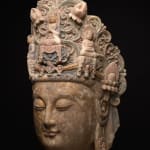Sui Marble Head of a Bodhisattva, 581 CE - 618 CE
Marble
66 x 35.6 cm
26 x 14 in
26 x 14 in
HK.5122
Further images
-
(View a larger image of thumbnail 1
)

-
(View a larger image of thumbnail 2
)

-
(View a larger image of thumbnail 3
)

-
(View a larger image of thumbnail 4
)

-
(View a larger image of thumbnail 5
)

-
(View a larger image of thumbnail 6
)

-
(View a larger image of thumbnail 7
)

-
(View a larger image of thumbnail 8
)

This is a marble sculpture of a Bodhisattva from Sui Dynasty. The deity is depicted wearing a huge crown, which still shows traces of red and yellowish paint. The head...
This is a marble sculpture of a Bodhisattva from Sui Dynasty. The deity is depicted wearing a huge crown, which still shows traces of red and yellowish paint. The head is characterized by fleshy features that harmonize the Sui dynasty’s emergent trend toward naturalism with the inherited idealized forms that conventionally conveyed the purity of Buddhist subjects. Here, the Bodhisattva’s broad arched brows and the sweep of the lowered lids lead the eye down the straight nose to the plump lips and slightly upturned chin, before following the softened jawline to the plump cheeks and returning upward to the crown of the head. The full oval face, gilded with gold, is counterbalanced above by a tall diadem. Even in its opulence, the diadem follows the standard Sui formula of a three-sided structure with aesthetic attention given to its band. Although the torso of the sculpture is missing we can postulate that it is originally in standing form, derived from its facial expression and downcast eyes. The extensively decorated crown depicts three Buddhas and five halos, possibly indicating the temporal and spatial tri-Buddhas, positioning the present Buddha Shakyamuni (Vairocana) at the centre. Hints of red suggests previous gilding of ferrous mineral paint. It is a showcase of splendid craftsmanship, which achieves a sense of three-dimensional perspective through intelligent carving, emphasizing the differences between background and foreground. The head belongs to a mature phase of Sui artistic production, when craftsmen synthesized styles from within and beyond China into graceful yet dynamic compositions that expressed the transcendental majesty of the Buddhist subject, diversifying the visual vocabulary of each region of the empire, while preserving established characteristics in production. Thus, this sculpture embodies the stylistic transition from the Northern Dynasties to Tang Dynasty.







